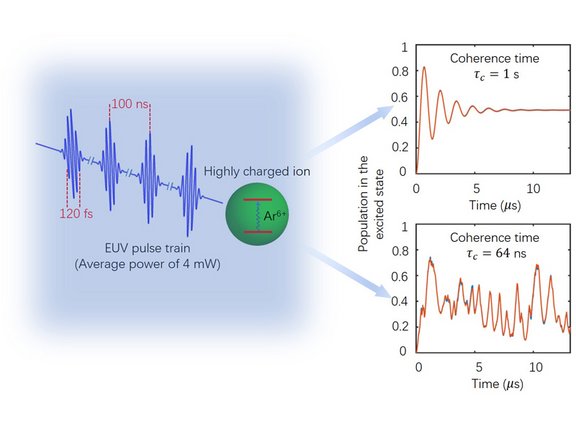A frequency comb is a uniform set of frequency peaks, a "ruler" in frequency space used in atomic spectroscopy. It is generated as a train of identical light pulses. In reality, laser noise effects cause fluctuations in the pulse-to-pulse time delay and phase. The time duration during which the pulses repeat regularly, i.e. the coherence time, is getting reduced, and the comb teeth are broadened. Optical combs with coherence times longer than 1 s have revolutionized spectroscopy in the past two decades. High-order harmonic generation (HHG) with infrared pulse trains can push combs from the optical range to higher frequencies, to the so far largely unexplored extreme ultraviolet (EUV) regime. It is believed that the same coherence property shall be preserved during the HHG process, thus EUV combs with long coherence times can also be realized. Nevertheless, this prediction is yet to be verified.
Recently, Chunhai Lyu in the Harman group of the Keitel division has put forward a scheme to infer the coherence time of an EUV frequency comb on the time scale of 1 ms to 1 s via frequency comb spectroscopy of highly charged ions. Certain ions have several EUV transitions to long-lived excited states and thus allow for the investigation of the coherence time. Numerical simulations show that while the ionic dynamics induced by a comb with 1-s long coherence time is deterministic, chaotic excitation dynamics is observed when the comb possesses a much shorter coherence time. The exact coherence time could consequently be extracted from the experimental excitation spectrum with respect to the frequency detuning between the comb teeth and the transition frequency. This scheme can be potentially realized at MPIK in the near future. The group of José R. Crespo López-Urrutia in the Pfeifer division has already successfully demonstrated a significant step towards an EUV frequency comb. When such combs are experimentally feasible, they will enable precision spectroscopy in an uncharted territory, and pave the way for next-generation atomic clocks.
Original publication:
C. Lyu, S. M. Cavaletto, C. H. Keitel, Z. Harman, "Interrogating the Temporal Coherence of EUV Frequency Combs with Highly Charged Ions", Phys. Rev. Lett. 125, 093201 (2020), DOI: 10.1103/PhysRevLett.125.093201
